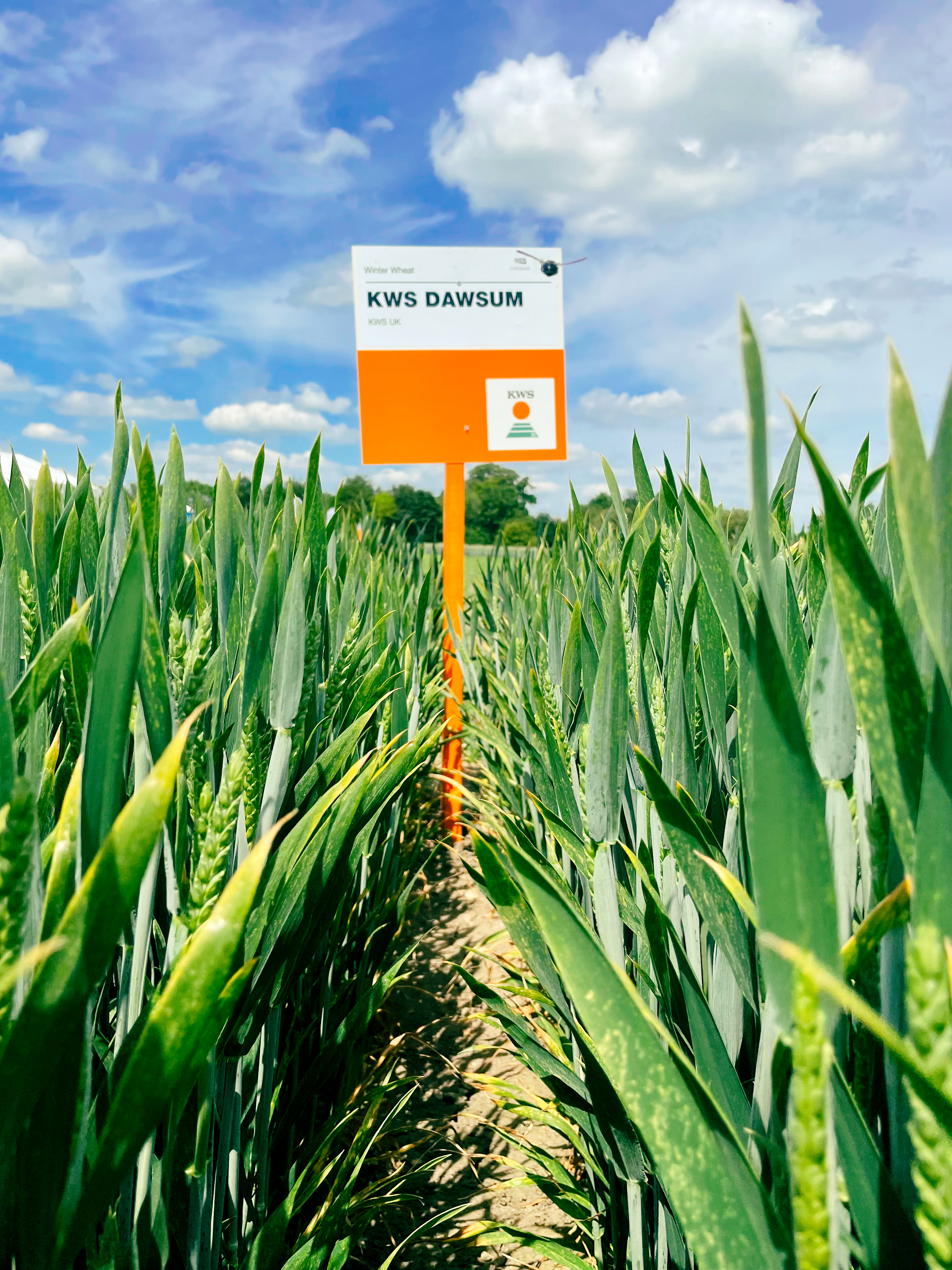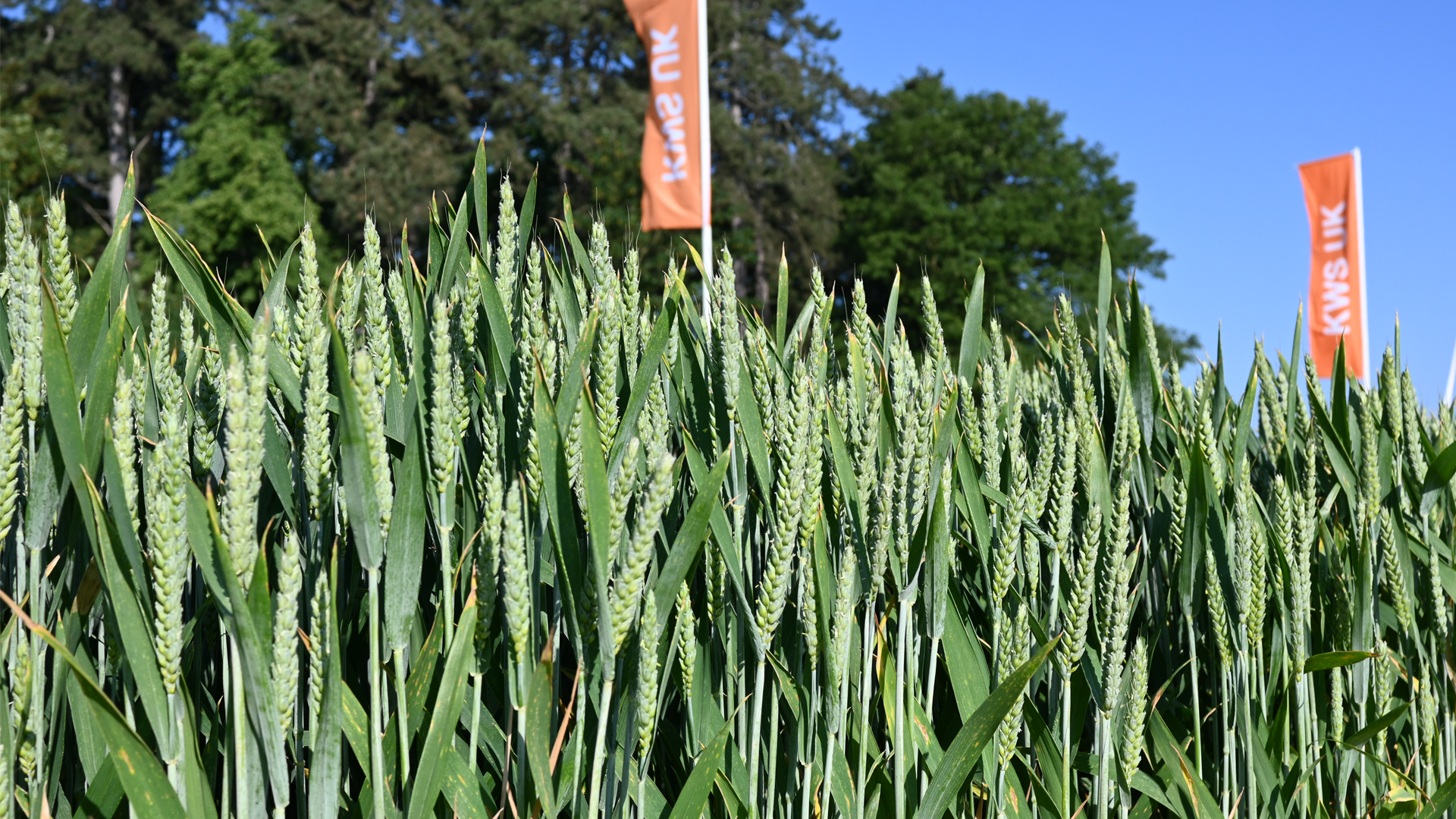Could the UK’s most popular Group 4 wheat also be the most sustainable?
Northumberland grower Jim Lang harvested his first crop of KWS Dawsum at West Ord Farm, Berwick-Upon-Tweed during 2022, achieving the farm’s top yield of 12t/ha with a specific weight of 83kg/hl.
So well did it perform that he has increased the area for 2023 harvest by fifty per cent.
A key factor in the decision to grow the high-yielding Group 4 hard feed is its suitability for early drilling, a vital consideration in an area where the weather can turn harsh very quickly in the autumn, he says.
“For the last five years all my winter wheat area has consisted of Group 4 hard feed varieties,” says Jim, who joined the YEN (Yield Enhancement Network) in 2021.
“That is because it is difficult to consistently achieve sufficient protein or Hagberg levels for other uses, and this approach simplifies storage.
“All the wheats yielded fantastically well last year and the average yield was significantly higher than the 10t/ha achieved in 2021.
“Everything came ready at the same time last year and harvest was finished on 13 August, six days earlier than ever before.
“With no rain to interrupt combining, wheats were down to 12% moisture, which is unheard of in this area, but temperatures were up to 30°C so the risk of field fires was ever present, and grain had to be ventilated as soon as it went into store to cool it down.
“KWS Dawsum was our highest yielding variety and averaged 12t/ha, which was very pleasing, followed by Grafton at 11.7t/ha.”
Exceptionally clean crop
The KWS Dawsum had been drilled on 16 September 2021 across two fields at 350 seeds/m2 on heavier soil following oilseed rape, 300/m2 on light land after spring oats.
No T0 was applied as its was felt there was not much point at that timing, Jim recalls.
“We do not have an issue with brown rust and because KWS Dawsum is rated 9 for yellow rust we did not need to apply a triazole fungicide, but at T1 the crop had Revystar® XE, Manganese and a PGR.
“At GS37 it received another PGR, then at GS42 1.25l/ha of Univoq™. At T3, 0.9l/ha of Pontoon was also applied. All wheats received the farm standard amount of Nitrogen, 250kgN/ha.
"The KWS Dawsum was very clean coming out of winter, even on the light land following spring oats, looking good throughout the season and produced the goods at harvest."
The crop now in the ground for harvest 2023 was drilled slightly later than the previous one, Jim recalls
“I usually aim to start drilling on 5 September and get all of the first wheats in by 20 September, because if the weather does break it can get very wet, very quickly.
“Last year, the ground was so dry that it was not possible to start drilling during the first week of September. Eventually we had a 30mm rain event which allowed us to begin on 13 September and all winter crops were in the ground by 25 September.
“The seed rate on our light land was 255/m2 and I went up to 400/m2 for second wheats, but for the KWS Dawsum it was 325/m2.
“KWS Dawsum is a variety with all the qualities I look for in a winter wheat and one which I think it will be around for many years.”
We looked at a number of trials and identified that the key attributes of KWS Dawsum would be ideal for his farm circumstances.
David Robinson, head of innovation and knowledge transfer at Frontier Agriculture Ltd and founder of the company’s Crop Dynamics division, of which Jimmy is a member, says KWS Dawsum has proven a very a good fit for the farm.
“I have worked with Jim on agronomy for almost 35 years and know how passionate he is about variety choice.
“With the weather patterns in The Borders as they are, standing power, bushel weight and disease profile are the fundamental building blocks for a variety to be successful.
“Because of the geographical locality of the farm, Septoria and yellow rust can be problematic in many seasons, too.
“We looked at a number of trials and identified that the key attributes of KWS Dawsum would be idea for his farm circumstances.
“The trials also indicated that the variety would have a medium to strong tillering capacity, which would also be an asset.”
In Frontier’s own trials when drilled in September, October and at the end of November it yielded 108%, 104% and 104% respectively.
According to KWS’ Dr. Kirsty Richards, KWS Dawsum’s high untreated yield is an indication of its built-in resilience and ability to deliver top performance in a range of different growing situations.
"New in 2022, KWS Dawsum has quickly established itself as the most popular hard Group 4 in the UK, offering ultimate flexibility on farm and fantastic yields right across the rotation.
“High untreated yields are becoming increasingly important as growers look to be more flexible with their inputs in the current economic environment and KWS Dawsum’s untreated yield at 95% is second only to KWS Extase at 97% on the latest RL.
"It's one of those few varieties that breaks the link between high yield and high care with its agronomic package and sheer versatility meaning it is likely to deliver in all production scenarios including ones with a regenerative focus."
A KWS Kerrin x Costello cross, KWS Dawsum is a classic ‘barn filler’ producing excellent yields across all UK regions in the early, main, and late sown slots, she says.
"The variety can be safely sown up until the end of January with a fantastic outright yield. In the latest RL, for example, early drilling yield is 107% whilst mainstream and late sown slots are still 104%.
"This offers real versatility, especially for growers in the North of the country. In the 2023/24 AHDB Recommended List KWS Dawsum achieves a yield of 104% for the UK as a whole but for the North this rises to 105%.
"It also has an exceptional specific weight of 80.0 kg/hl - one of the highest on the market today.
“Vigorous growth habit also means that the variety is also likely to perform well in a direct drilling situation, a technique which is likely to gain further in popularity as growers seek to reduce their establishment costs.
“Its excellent yields across a range of drilling dates are enhanced by the variety’s exceptionally marketable grain and a robust disease package which includes a 6.4 for Septoria, 8 for mildew and 9 for yellow rust."
Why high yielding Group 4s are still the backbone of UK wheat production
High yielding Group 4s with strong agronomic traits are likely to remain the backbone of future rotations as higher input costs start to bite, producers aim to reduce agrochemical use and the loss of BPS takes effect, says James Webster, senior analyst with farm business consultancy The Anderson Centre.
“High yield potential is still a key requirement as this sets the benchmark for production and it’s not just about tonnes either. High specific weight is increasingly important as is protein content.
"Nitrogen efficiency is also going to be under the spotlight in the future with varietal traits such as vigour, robust root systems, straw strength and disease resistance all contributing to this.
“High untreated yields are a good indicator of a variety’s overall resilience but they are also key when trying to use agrochemicals more effectively, as we will have to in the future as environmental legislation increases."
Working with the company’s 600ha Loam Farm business model to see how the incremental gain from such traits can impact on the bottom line produces some interesting results, he says.
“Loam Farm does not take account of varietal differences in yield, so we started by looking at KWS Dawsum and its +2% yield advantage at 104% of control in the AHDB 2023/24 RL compared to an average of around 102% for Group 4 as a whole.
“Similarly, with KWS Dawsum’s untreated yield at 95% of control compared to a Group 4 average of 86%, we thought a 6% saving in spray costs was not unreasonable.
"The effect of these gains is to take net margin before subsidy from £138/ha to £190/ha – an increase of nearly 38% - and if a 5% improvement in Nitrogen utilisation is added, this rises to £210/ha – a 52% improvement in net margin.
“It just shows how important these gains are to the overall profitability of the business, particularly in a future where there is no BPS."
Your consultants



